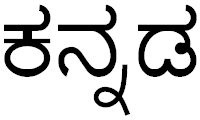Kannada facts for kids
Quick facts for kids Kannada |
||||
|---|---|---|---|---|
| ಕನ್ನಡ kannaḍa | ||||
 |
||||
| Native to | India - Karnataka, Kasaragod, Kerala, Maharashtra, Andhra pradesh, Goa, Tamil Nadu and significant communities in Mauritius, United Arab Emirates, Thailand. | |||
| Ethnicity | Kannadiga | |||
| Native speakers | 60 million (2011) 11.4 million as a second language |
|||
| Language family | ||||
| Writing system | Kannada alphabet (Brahmic) Kannada Braille |
|||
| Official status | ||||
| Official language in | Karnataka | |||
| Regulated by | Various academies and the Government of Karnataka | |||

Distribution of native Kannada speakers in India
|
||||
|
|
||||
Kannada (ಕನ್ನಡ) is a language spoken mainly in India. It is also the name of the writing system used for this language. Most people in the southern Indian state of Karnataka speak Kannada. You can also find Kannada speakers in Andhra Pradesh, Tamil Nadu, Maharashtra, Kerala, and Goa. There are about 60 million people who speak Kannada.
Kannada is part of the Dravidian language family. This family is different from the Indo-European languages like Hindi, which are spoken in northern India. However, Dravidian languages are similar to other southern Indian languages, such as Telugu. Kannada has a long history, with written records going back about 1500 years.
Contents
History of Kannada Language
Ancient Roots
The earliest form of the language is called Old Kannada. Over time, it slowly changed into the Kannada and Telugu scripts we know today. Around the year 1500, these scripts became more distinct.
Modern Changes
In the early 1800s, Christian missionaries brought printing presses to India. This helped to make the Kannada and Telugu scripts more standard. It meant that everyone started writing them in a more uniform way.
How Kannada is Written
The Kannada script is a special type of writing system. It is called an alphasyllabary. This means that each consonant letter already has a vowel sound built into it.
Vowels and Consonants
If you need a different vowel sound, you add small marks called diacritics. These marks appear next to the consonant. When a vowel starts a word or syllable, it is written as a separate letter.
Joining Letters
Sometimes, consonants appear together without any vowels in between. In these cases, the second consonant is written as a special combined symbol. This symbol usually appears below the first consonant. Kannada is written from left to right in straight lines, just like English.
Interesting Facts About Kannada
Kannada has received the highest number of Janapeeta literary awards. These are very important awards for Indian literature. The language got a big boost during the time of the Vijayanagara Empire.
Shri Vinoba Bhave, a famous Indian leader, once called the Kannada script "the Queen of World Scripts." He said it was the "Vishwa Lipigala Raani," which means "Queen of World Scripts" in Kannada.
Images for kids
-
Old-Kannada inscription of c. AD 726, discovered in Talakad, from the rule of King Shivamara I or Sripurusha (Western Ganga Dynasty)
-
The famous Atakur inscription (AD 949) from Mandya district, a classical Kannada composition in two parts; a fight between a hound and a wild boar, and the victory of the Rashtrakutas over the Chola dynasty in the famous battle of Takkolam
-
Old-Kannada inscription ascribed to King Vikramaditya VI (Western Chalukya Empire), dated AD 1112, at the Mahadeva Temple in Itagi, Koppal district of Karnataka state
-
Old-Kannada inscription of AD 1220 (Hoysala Empire) at Ishwara temple of Arasikere town in the Hassan district
-
Kannada inscription dated 1509, of King Krishnadevaraya (Vijayanagara Empire), at the Virupaksha temple in Hampi describes his coronation
See also
 In Spanish: Idioma canarés para niños
In Spanish: Idioma canarés para niños














